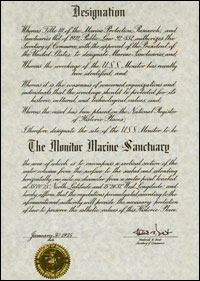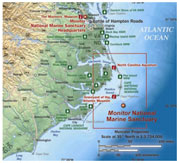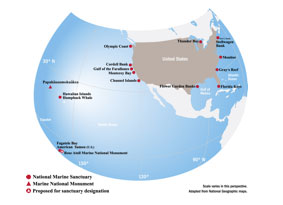
| |
Designation of Monitor National Marine Sanctuary
| |  | |
| | Click here for a larger view of the
designation document. |
Official announcements of the Monitor discovery created a strong interest from the public and some enthusiastic proposals for raising the famous warship. However, government officials were wrestling with the more basic problem of how to protect the Monitor's remains. North Carolina's submerged cultural resource law could not protect the wreck from salvage efforts because it lay outside the three-mile limit, and therefore, outside the jurisdiction of the state. The U.S. Navy had abandoned title to the Monitor in 1953. Agencies involved in locating and identifying the Monitor, as well as the Smithsonian Institution and others, organized efforts to identify a means of preserving the wreck.
After surveying existing federal legislation, the working group determined that Title III of the Marine Protection, Research and Sanctuaries Act of 1972, which authorized creation of marine protected areas under the jurisdiction of the National Oceanic and Atmospheric Administration, offered the best means of protecting the Monitor. The governor of North Carolina nominated the wreck for marine sanctuary status and on Jan. 30, 1975, the 113th anniversary of the vessel's launch, Monitor National Marine Sanctuary — the nation's first marine sanctuary — was created.
| |
|
|
|

The USS Monitor lies in approximately 240 feet of water just 16 miles south-southeast of Cape Hatteras, N.C. Click here for a larger map. (Courtesy NOAA)
. . . . . . . . . . . .
 The Monitor National Marine Sanctuary was the first sanctuary of what now includes 14 marine protected areas in U.S. waters. The sanctuary system spans from Thunder Bay in the Great Lakes (the only fresh water sanctuary), to Fagatele Bay in American Samoa. With over 150,000 square miles of America's ocean and Great Lakes waters protected, NOAA's Office of National Marine Sanctuaries works to conserve, protect, and enhance the biodiversity, ecological integrity, and cultural legacy of these special underwater places. (Courtesy NOAA) Click here for a larger map. The Monitor National Marine Sanctuary was the first sanctuary of what now includes 14 marine protected areas in U.S. waters. The sanctuary system spans from Thunder Bay in the Great Lakes (the only fresh water sanctuary), to Fagatele Bay in American Samoa. With over 150,000 square miles of America's ocean and Great Lakes waters protected, NOAA's Office of National Marine Sanctuaries works to conserve, protect, and enhance the biodiversity, ecological integrity, and cultural legacy of these special underwater places. (Courtesy NOAA) Click here for a larger map.
|
|
|
|


 indicates a link leaves the site. Please view our Link Disclaimer | Contact Us | http://monitor.noaa.gov/150th/includes/footer.html
indicates a link leaves the site. Please view our Link Disclaimer | Contact Us | http://monitor.noaa.gov/150th/includes/footer.html